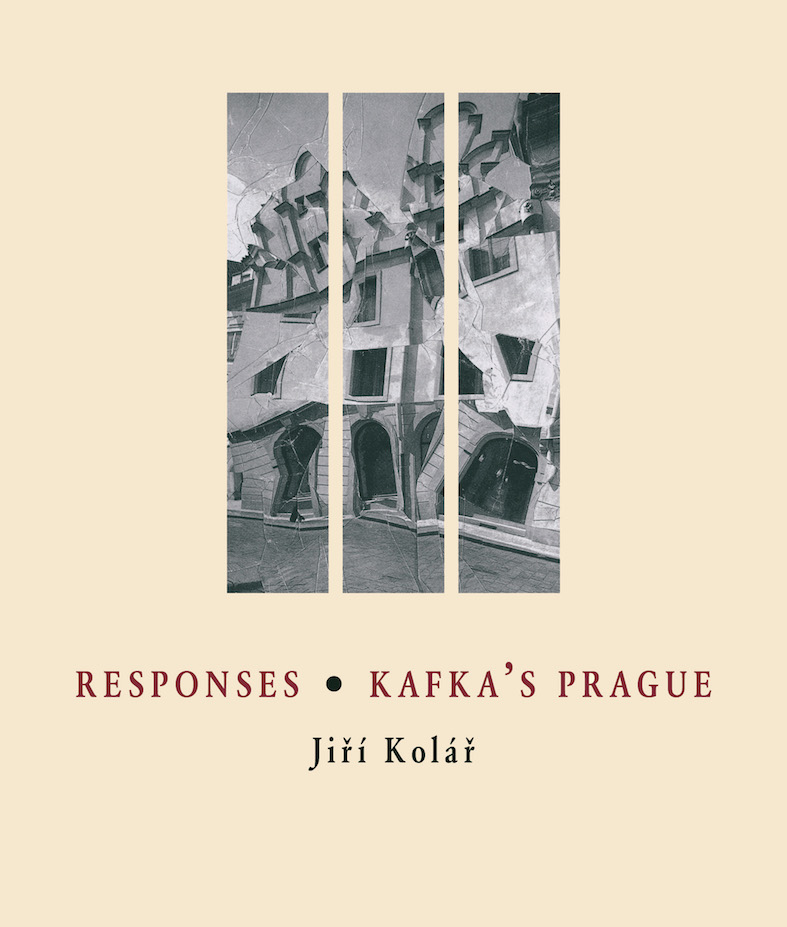| |

[ excerpt ]
book view
series: image to word #6

also by the author:
A User’s Manual
|
|
responses • kafka’s prague
by Jiří Kolář
translated from the Czech by Ryan Scott
Kafka translations by Kevin Blahut
artwork by the author
Written and compiled in the 1970s but facing virtually no prospect of being published in communist Czechoslovakia,
“Responses”
and “Kafka’s Prague” first appeared together in 1984 with the exile publishing house Index based in Cologne, Germany. The text discusses Kolář’s influences
and his wide variety of collage techniques as well as his views on art and literature in general. “Kafka’s Prague” is a series of color crumplages
of Prague’s buildings, streets, squares, and gardens accompanied by short extracts from Franz Kafka’s work, which was likewise banned by the regime,
as a sort of homage to the city whose artistic vitality was being snuffed out by communist repression. Taken together, the result is a fascinating document
akin to an artist’s book that captures Kolář’s creative flux at a particular moment in time.
Crumplage is a technique developed by Kolář in which a
sheet of paper or reproduction is crumpled at random and then flattened out and pasted
onto a backing, creating a deformation of the original image or a new image. As he explained it in his Dictionary of Methods:
“Crumplage washed over me on a huge wave of gesturalism during a period when the graphic artist Vladimír Boudník
was running his marathon in Bohemia fueled to the hilt by Explosionalism and structural prints. The first crumplages I made were monochrome,
either white or black. Anyone can crumple wet paper, and if that doesn’t work, all you need to do is toss a few magazine pages onto the
sidewalk in the rain. The rain and the trampling of passersby or the tires of cars will do the trick. Believe me,
I’ve tried this many
times, and Boudník was the only one
who didn’t thumb his nose at me. This didn’t surprise me.
He was one of the very few who knew how
to read a picture
in creases, on walls, etc. ... The analogies to events in life and explosions of fate, which can ‘crumple’ a person
so suddenly and profoundly that the consequences of such an inner tornado can never be smoothed or straightened out, convinced me
that this technique of mine was indeed
useful for gaining insight.”

It all makes for a quite fascinating double-work, Responses • Kafka's Prague offering insight into a remarkable artist as well as a striking set of examples of his visual work.
The Twisted Spoon Press edition is, like all their books, a beautiful volume, too – this is a lovely book. |
— M.A. Orthofer, The Complete Review
|
Putting the two halves of the book together, one could say that Responses introduces the reader to a theory of poetry and art in interaction, at least insofar as anything like a theory can be abstracted
from Kolář’s fragmented commentary. Subsequently, in Kafka’s Prague, we are offered the chance to see that theory put into practice by a master practitioner using one of his favourite techniques. The
book as a whole seems to invite its readers to judge for themselves not just how effective such juxtaposition of word and image may be but also what kind of effects it might generate when transposed
into a different cultural context. |
— Alena Dvořáková, Dublin Review of Books
|
”Kafka’s Prague” is an entertaining and thought-provoking sequence, with deconstructed and re-imagined buildings, reproduced in full colour, opposite brief and elusive fragments from
Kafka, often to do with death, dreams and confusion. But it is “Responses” that has enthralled me. |
— Rupert Loydell, Tears In the Fence
|
It has a thoughtful, conversational, musing-out-loud sort of feel and a sense of direction that is not explicit or artificial but gives the work a natural flow. From the outset,
Kolář makes it clear that he sees art as part of the “general drive toward universal knowledge” and as such there can be nothing extrinsically new that is not a departure from that which is already innate
to the practice. Art and literature are disciplines that do not create anything new so much as they create new ways of looking at (and using) what is already there, a “special type of perception.” |
— roughghosts
|
This is to be recommended for admirers of A User’s Manual, Kolář’s jaunty set of suggestions for artistic procedures, brought out in
English by the same publisher and translator in 2019. |
— Michael Caines, TLS
|
In extending the techniques and topics of the past to match the contingencies and urgencies of the present Kolář
felt as if neither images nor words by themselves was enough [...] One of those methods – “crumplage” (crumple + collage) — involved taking
found images from books and newspapers and altering them. The impulse for this was beyond producing Dadaist or Surrealist pictures but
was intended to convey senses of loss and beginnings. |
— Tom Bowden, Book Beat
|
|
|
 |
|

ISBN 9788086264578
133 pp., 17 x 20 cm
smyth-sewn softcover
with flaps
34 color plates
prose : art : literature
release dates:
Europe: July 2021
UK: Sept. 13, 2021
US: Nov. 22, 2021
Order directly:
airmail postage & handling incl.
or order from:
Book Depository
Bookshops
Indiebound
Shakespeare & Sons
Bookshop.org
Bookshop.org UK
Amazon US
Amazon UK
Central Books
e-book
Amazon US
Amazon UK
Amazon Canada
Amazon Australia
Amazon Germany
Amazon India
Amazon Japan
Apple iBooks
Kobo
|